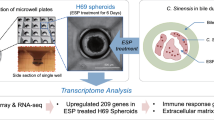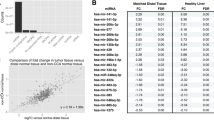Abstract
Clonorchis sinensis is a carcinogenic human liver fluke by which chronic infection is strongly associated with the development of cholangiocarcinoma. Although this cholangiocarcinoma is caused by both physical and chemical irritation from direct contact with adult worms and their excretory–secretory products (ESPs), the precise molecular events of the host–pathogen interactions remain to be elucidated. To better understand the effect of C. sinensis infection on cholangiocarcinogenesis, we profiled the kinetics of changes in cancer-related microRNAs (miRNAs) in human cholangiocarcinoma cells (HuCCT1) treated with C. sinensis ESPs for different periods. Using miRNA microarray chips containing 135 cancer-related miRNAs, we identified 16 miRNAs showing differentially altered expression following ESP exposure. Of these miRNAs, 13 were upregulated and 3 were downregulated in a time-dependent manner compared with untreated controls. Functional clustering of these dysregulated miRNAs revealed involvement in cell proliferation, inflammation, oncogene activation/suppression, migration/invasion/metastasis, and DNA methylation. In particular, decreased expression of let-7i, a tumor suppressor miRNA, was found to be associated with the ESP-induced upregulation of TLR4 mRNA and protein, which contribute to host immune responses against liver fluke infection. Further real-time quantitative PCR analysis using ESP-treated normal cholangiocytes (H69) revealed that the expressions of nine miRNAs (miR-16-2, miR-93, miR-95, miR-153, miR-195, miR-199-3P, let7a, let7i, and miR-124a) were similarly regulated, indicating that the cell proliferation and inhibition of tumor suppression mediated by these miRNAs is common to both cancerous and non-cancerous cells. These findings constitute further our understanding of the multiple cholangiocarcinogenic pathways triggered by liver fluke infection.



Similar content being viewed by others
References
Blechacz B, Gores GJ (2008) Cholangiocarcinoma: advances in pathogenesis, diagnosis, and treatment. Hepatol 48:308–321
Bouvard V, Bann R, Straif K, Grosse Y, Secretan B, Ghissassi F, Benbbrahim-Tallaa L, Guha N, Freema C, Galichet L, Cogliano V (2009) A review of human carcinogens-PartB: biological agents. Lancet Oncol 10:321–322
Braconi C, Huang N, Patel T (2010) MicroRNA-dependent regulation of DNA methytransferase-1 and tumor suppressor gene expression by interlukin-6 in human malignant cholangiocyte. Hepatol 51:881–890
Bussing I, Slack FJ, Groβhans (2008) let-7 microRNAs in development, stem cells and cancer. Trends Mol Med 14:400–409
Chen XM, Splinter PL, O’Hara SP, LaRusso NF (2007) A Cellular micro-RNA, let-7i, regulates Toll Like receptor 4 expression and contributes to cholangiocyte immune responses against Cryptosporidium parvum infection. J Biol Chem 39:28929–28938
Du WW, Fang L, Li M, Yang X, Liang Y, Peng C, Qian W, O’Malley YQ, Askeland RW, Sugg SL, Qian J, Lin J, Jiang Z, Yee AJ, Sefton M, Deng Z, Shan SW, Wang CH, Yang BB (2013) MicroRNA miR-24 enhances tumor invasion and metastasis by targeting PTPN9 and PTORF to promote EGF signaling. J Cell Sci 126:1440–1453
Esquela-Kerscher A, Slack FJ (2006) Oncomirs—microRNAs with a role in cancer. Nature Rev 6:259–269
Fang L, Du WW, Yang W, Rutnam ZJ, Peng C, Li H, O’Malley YQ, Askeland RW, Sugg S, Liu M, Mehta, Deng Z, Yang BB (2012) MiR-93 enhances angiogenesis and metastasis by targeting LATS2. Cell Cycle 11:4352–4365
Furuta M, Kozaki K, Tanimoto K, Tanaka S, Arii S, Shimamura T, Niida A, Miyano S, Inazawa J (2013) The tumor-suppressive miR-497-195 cluster targets multiple cell-cycle regulators in hepatocellular carcinoma. PLoS One 8(1–12):E60155
Galihouste L, Go’mez-Santos L, Ochiya T (2013) Potential application of miRNAs as diagnostic and prognostic markers in liver cancer. Front Biosci 18:199–223
Hu Y, Correa AM, Hoque A, Guan B, Ye F, Huang J, Swister SG, Wu TT, Ajani JA, Xu XC (2011) Prognostic significance of differentially expressed miRNAs in esophageal cancer. Int J Cancer 128:132–143
Huang Z, Huang S, Wang Q, Liang L, Ni S, Wang L, Sheng W, He X, Du X (2011) MicroRNA-95 promotes cell proliferation and targets sorting Nexin 1 in human colorectal carcinoma. Cancer Res 71:2582–2589
Karakatsanis A, Papaconstantinou I, Gazouli M, Lyberopoulou A, Polymenneas G, Voros D (2013) Expression of microRNAs, miR-21, miR-31, miR-122, miR-145, miR-146a, miR-200c, miR-221, miR-222, and mir-223 in patients with hepatocellular carcinoma or intrahepatic cholangiocarcinoma and its prognostic significance. Mol Carcinog 52:297–303
Kim YJ, Choi MH, Hong ST, Bae YM (2008) Proliferative effects of excretory/secretory products from Clonorchis sinensis on human epithelial cell line HEK293T via regulation of the transcription factor E2F1. Parasitol Res 102:411–417
Kim DW, Kim JY, Moon JH, Kim KB, Kim TS, Hong SJ, Cheon YP, Pak JH, Seo SB (2010) Transcriptional induction of minichromosome maintenance protein 7 (Mcm7) in human cholangiocarcinoma cells treated with Clonorchis sinensis excretory-secretory products. Mol Biochem Parasitol 173:10–16
Lee DY, Jeyapalan Z, Fang L, Yang J, Zhang Y, Yee AY, Li M, Du WW, Shatseva T, Yang BB (2010) Expression of versican 3′-untranslated region modulates endogenous microRNA functions. PLoS One 5(1–12):E13599
Lee H, Park CS, Deftereos G, Morihara J, Stern JE, Hawes SE, Swisher E, Kiviat NB, Feng Q (2012) MicroRNA expression in ovarian carcinoma and its correlation with clinicopathological features. World J Surg Oncol 10:174
Liu P, Wilson MJ (2011) miR-520c and miR-373 upregulate MMP9 expression by targeting mTOR and SIRT1, and activate the Ras/Raf/MEK/Erk signaling pathway and NF-κB factor in human fibrosarcoma cells. J Cell Physiol 227:867–876
Liu H, Brannon AR, Reddy AR, Alexe G, Seiler MW, Arreola A, Oza JH, Yao M, Juan D, Liou LS, Ganesan S, Levine AJ, Rathmell WK, Bhanot GV (2010a) Identifying mRNA targets of microRNA dysregulated in cancer: with application to clear cell renal cell carcinoma. BMC Syst Biol 4:51
Liu X, Sempere LF, Ouyang H, Memoli VA, Andrew AS, Luo Y, Demidenko E, Korc M, Shi W, Preis M, Dragnev KH, Li H, DiRenzo J, Bak M, Freemantle SJ, Kauppinen S, Dmitrovsky E (2010b) MicroRNA-31 functions as an oncogenic miRNA in mouse and human lung cancer cells by repressing specific tumor suppressors. J Clin Invest 120:1298–1309
Lu X, Yue X, Cui Y, Zhang J, Wang KW (2013) MicroRNA-124 suppresses growth of human hepatocellular carcinoma by targeting STAT3. Biochem Biophy Res Comm 441:873–879
Nam JH, Moon JH, Kim IK, Lee MR, Hong SJ, Ahn JH, Chung JW, Pak JH (2012) Free radicals enzymatically triggered by Clonorchis sinensis excretory-secretory products cause NF-κB-mediated inflammation in human cholangiocarcinoma cells. Int J Parasitol 42:103–113
Namwat N, Chusorn P, Loilome W, Techasen A, Puetkasichonpasutha J, Pairojkul C, Khuntikeo N, Yongvanit P (2012) Expression profiles of oncomir miR-21 and tumor suppressor let-7a in the progression of opisthorchiasis-associated cholangiocarcinoma. Asian Pac J Cancer Prev 13:65–69
Ozdemir F, Altinisik J, Karateke A, Coksuer H, Buyru N (2012) Methylation of tumor suppressor genes in ovarian cancer. Exp Ther Med 4:1092–1096
Pak JH, Kim DW, Moon JH, Nam JH, Kim JH, Ju JW, Kim TS, Seo SB (2009a) Differential gene expression profiling in human cholangiocarcinoma cells treated with Clonorchis sinensis excretory-secretory products. Parasitol Res 104:1035–1046
Pak JH, Moon JH, Hwang SJ, Cho SH, Seo SB, Kim DS (2009b) Proteomic analysis of differentially expressed proteins in human cholangiocarcinoma cells treated with Clonorchis sinensis excretory-secretory products. J Cell Biochem 108:1376–1388
Prakobwong S, Yongvanit P, Hiraku Y, Pairojkul, Sithithaworn P, Pinlaor P, Pinlaor S (2010) Involvement of MMP-9 in peribiliary fibrosis and cholangiocarcinogenesis via Rac1-dependent DNA damage in a hamster model. Int J Cancer 127:2576–2587
Rustagi T, Dasanu CA (2012) Rish factors for gallbladder cancer and cholangiocarcinoma: similarities, differences and updates. J Gastrointest Cancer 43:137–147
Serradell MC, Guasconi L, Cervi L, Chiapello LS, Masih DT (2007) Excretory-secretory products from Fasciola hepatica induce eosinophil apoptosis by a caspase-dependent mechanism. Vet Immunol Immunopathol 117:197–208
Shatseva T, Lee DY, Deng Z, Yang BB (2011) MicroRNA miR-199a-3p regulates cell proliferation and survival by targeting caveolin-2. J Cell Sci 124:2826–2836
Shen S, Yue H, Li Y, Qin J, Li K, Liu Y, Wang J (2014) Upregulation of miR-136 in human non-small cell lung cancer cells promotes Erk1/2 activation by targeting PPP2R2A. Tumor Biol 35:631–640
Sripa B, Brindley PJ, Mulvenna J, Laha T, Smout MJ, Mairiang E, Bethony JM, Loukas A (2012) The tumorigenic liver fluke Opisthorchis viverrini—multiple pathways to cancer. Trends Parasitol 28:395–407
Thuwajit C, Thuwajit P, Kaewkes S, Sripa B, Uchida K, Miwa M, Wongkham S (2004) Increased cell proliferation of mouse fibroblast NIH-3T3 in vitro induced by excretory/secretory product(s) from Opisthorchis viverrini. Parasitology 129:455–464
Wei Y, Nazari-Jahantigh M, Chan L, Zhu M, Heyll K, Corbalán-Campos J, Hartmann P, Thiemann A, Weber C, Schober A (2013) The microRNA-342-5p fosters inflammatory macrophage activation through an Akt1- and microRNA-155-dependent pathway during atherosclerosis. Circulation 127:1609–1619
Wu Z, He B, He J, Mao X (2013) Upregulation of miR-153 promotes cell proliferation via downregulation of the PTEN tumor suppressor gene in human prostate cancer. Prostate 73:596–604
Xie L, Zhang Z, Tan Z, He R, Zeng X, Xie Y, Li S, Tang G, Tang H, He X (2014) microRNA-124 inhibits proliferation and induces apoptosis by directly repressing EZH2 in gastric cancer. Mol Cell Biochem 392:153–159
Zhang B, Pan X, Cobb GP, Anderson TA (2007) microRNAs as oncogenes and tumor suppressors. Dev Biol 302:1–12
Zhang W, Zhang J, Hoadley K, Kushwaha D, Ramakrishnan V, Li S, Kang C, You Y, Jiang C, Song SW, Jiang T, Chen CC (2012) miR-181d: a predictive glioblastoma biomarker that downregulates MGMT expression. Neurol-Oncol 14:712–719
Acknowledgments
We thank Drs. Dae Ghon Kim for donating H69 cells and Hye Ryung Jun for assistance in the early phases of the study. This study was supported by a National Research Foundation of Korea (NRF) grant funded by the Korea Government (MEST) (No. 2012R1A2A2A01014237).
Conflict of interest
The authors declare that they have no conflict of interest.
Author information
Authors and Affiliations
Corresponding author
Rights and permissions
About this article
Cite this article
Pak, J.H., Kim, I.K., Kim, S.M. et al. Induction of cancer-related microRNA expression profiling using excretory-secretory products of Clonorchis sinensis . Parasitol Res 113, 4447–4455 (2014). https://doi.org/10.1007/s00436-014-4127-y
Received:
Accepted:
Published:
Issue Date:
DOI: https://doi.org/10.1007/s00436-014-4127-y




